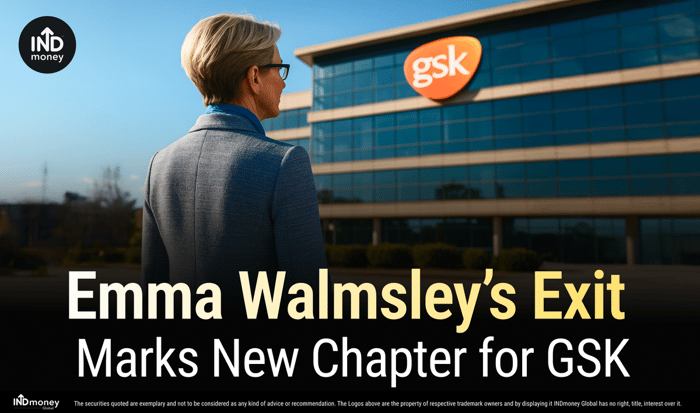
- Who is Emma Walmsley, the Outgoing GSK CEO?
- GSK’s Strategic scorecard under Walmsley
- Why Does Emma Walmsley’s Exit Matter?
- Who is Emma Walmsley’s successor Luke Miels?
- Investor takeaways from Walmsley's Exit
- GSK’s Governance and Timing
- What to watch next?
GSK has initiated a CEO transition, confirming that Dame Emma Walmsley will step down after nearly nine years at the helm, with Chief Commercial Officer Luke Miels named CEO-designate and slated to take over effective 1 January 2026.
The British multinational pharmaceutical and biotechnology company announced the succession plan on 29 September, positioning for continuity while signalling a sharpened focus on late-stage assets and commercial execution.
Let’s break down who Emma Walmsley is and why her exit matters for the pharma giant.
Who is Emma Walmsley, the Outgoing GSK CEO?
Appointed as CEO of GlaxoSmithKline in 2017, Walmsley made history as the first woman to lead a top-ten global pharmaceutical company. Before rising to the helm, she built her career at L’Oréal, where she spent 17 years in leadership roles across marketing and management, before joining GSK in 2010 to head its Consumer Healthcare division.
Walmsley’s blend of consumer-brand expertise and strategic vision helped her reposition GSK in an era when Big Pharma was undergoing rapid transformation.
Emma Walmsley’s Key Achievements as GSK CEO
- Haleon Spin-Off (2022): Successfully separated GSK’s consumer health division into Haleon, creating a standalone consumer health giant.
- R&D Transformation: Refocused GSK’s research priorities on vaccines, infectious diseases, respiratory, and oncology, strengthening the late-stage pipeline.
- COVID-19 Response: Led strategic collaborations with Sanofi and CureVac to contribute to global vaccine and therapeutic development.
- Shareholder Value Protection: Defended against a £50 billion Unilever bid for the consumer health arm and reinforced GSK’s independence.
- Pharma Identity Reset: Streamlined GSK into a vaccines- and specialty pharma-focused company with clearer long-term growth visibility.
GSK’s Strategic scorecard under Walmsley
GSK exits this chapter with a tighter, more vaccine-centric identity and a clearer growth algorithm. The company has repeatedly flagged a line-of-sight to 15 potential blockbuster launches by 2031, anchored by vaccines and specialty pharma. The Haleon demerger simplified the equity story, even as the core pharma business faced scrutiny on relative share performance during her watch. Net-net: a leaner GSK with a deeper late-stage mix and a board signalling “evolution, not revolution” with an internal successor.
Why Does Emma Walmsley’s Exit Matter?
Walmsley’s tenure since 2017 has been one of the most consequential in Big Pharma. She reset R&D priorities around vaccines, infectious disease, respiratory and immunology, and steered GSK’s balance sheet through COVID-era volatility. The succession caps a high-visibility run where GSK defended its strategy against activist pressure and rejected a proposed £50 billion sale of its consumer arm pre-spinoff, moves that defined the company’s standalone pharma profile.
Who is Emma Walmsley’s successor Luke Miels?
Miels is an insider with deep big-pharma pedigree (AstraZeneca, Sanofi, Roche) who joined GSK in 2017 and helped scale specialty medicines. Markets liked the signal as GSK share price rose more than 3% on September 29, according to Google Finance, suggesting investors expect steadier execution and pipeline velocity under a commercially minded operator.
Investor takeaways from Walmsley's Exit
- Continuity with a twist: Insider successor reduces transition risk while refocusing the story on launch execution and revenue conversion from late-stage assets.
- Credibility in commercialisation: Miels’ background suggests tighter GTM playbooks for specialty medicines and vaccines, where payer dynamics and launch sequencing drive returns.
- Market validation: The rally indicates investors were primed for an execution-first pivot; near-term catalysts will be readouts, approvals, and uptake curves rather than structural breakups.
GSK’s Governance and Timing
The choreography is deliberate. By naming a CEO-designate now and setting a fixed start date for 1 January 2026, GSK gives stakeholders four quarters to de-risk the transition, align leadership bands, and synchronise capital allocation with pipeline readouts. It also preserves continuity around investor messaging while allowing Walmsley to complete key milestones before handing over the reins.
What to watch next?
- Board and LTIP signals: Any refresh to GSK’s medium-term guidance, capital returns, or incentive design under Miels will be a tell on strategic emphasis.
- Pipeline to P&L translation: Track approvals and early sales curves for late-stage assets flagged in prior guidance; investors will expect clean execution and disciplined spend.
- Street sentiment: Initial pop aside, consensus will re-rate only if GSK lands sequential beats on launches and margins through 2026.
This is a well-messaged succession that keeps GSK’s strategy intact while tilting the spotlight to operational discipline. Walmsley exits having reshaped the company with the Haleon spin and a vaccines-first profile; Miels inherits a clearer runway and the burden of proof to turn a broadened pipeline into durable, compounding cash flows.
Disclaimer:
The content is meant for education and general information purposes only. Investments in the securities market are subject to market risks, read all the related documents carefully before investing. Past performance is not indicative of future returns. The securities quoted are exemplary and are not a recommendation. This in no way is to be construed as financial advice or a recommendation to invest in any specific stock or financial instrument. The figures mentioned in this article are indicative and for general informational purposes only. Readers are encouraged to verify the exact numbers and financial data from official sources such as company filings, earnings reports, and financial news platforms. The Company strongly encourages its users/viewers to conduct their own research, and consult with a registered financial advisor before making any investment decisions. All disputes in relation to the content would not have access to an exchange investor redressal forum or arbitration mechanism. Registered office address: Office No. 507, 5th Floor, Pragya II, Block 15-C1, Zone-1, Road No. 11, Processing Area, GIFT SEZ, GIFT City, Gandhinagar – 382355. IFSCA Broker-Dealer Registration No. IFSC/BD/2023-24/0016, IFSCA DP Reg No: IFSC/DP/2023-24/010.